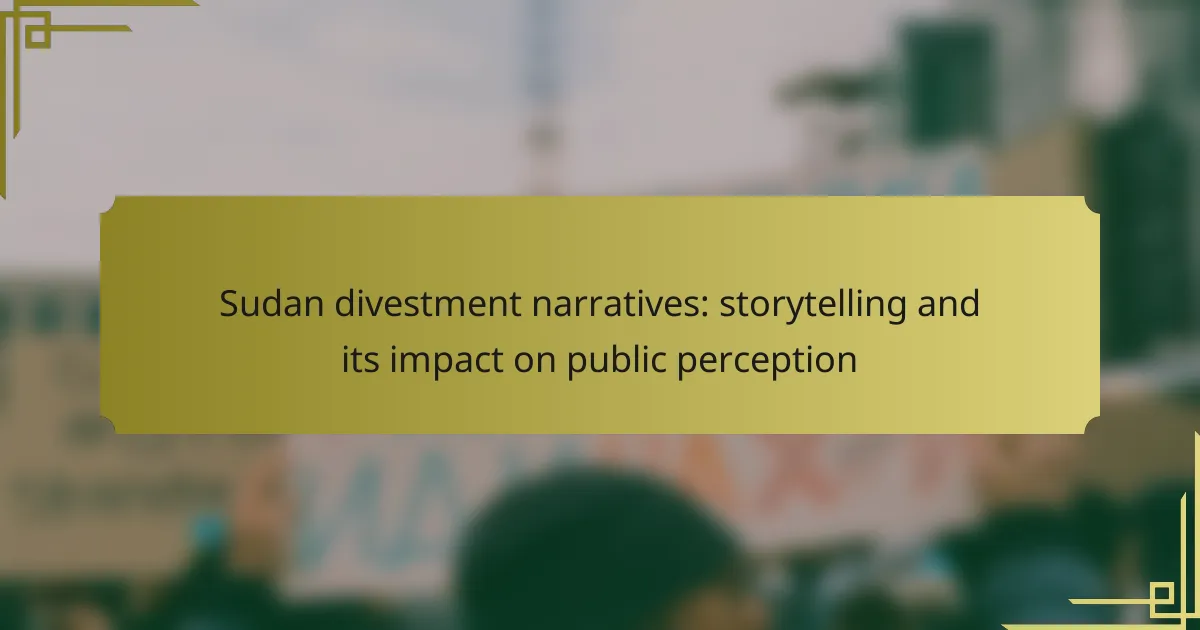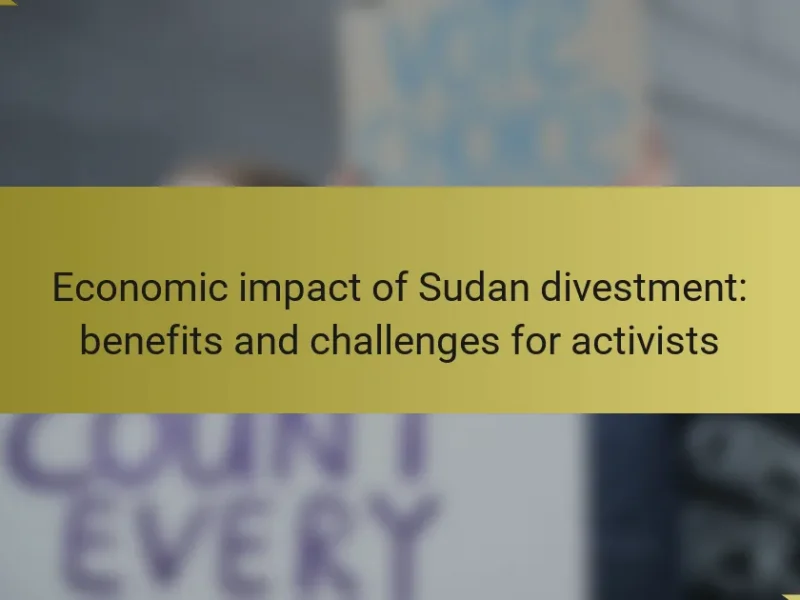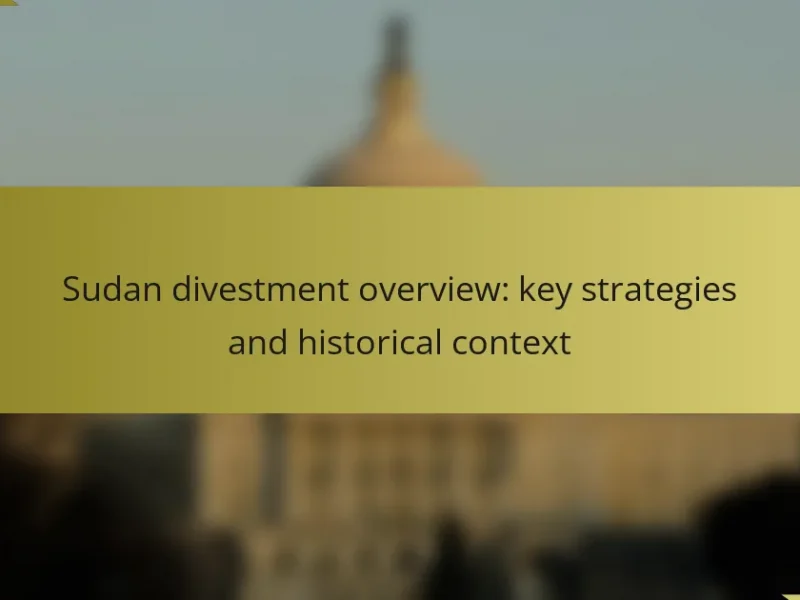Sudan divestment narratives are arguments advocating for the withdrawal of investments from entities linked to the Sudanese government, primarily due to human rights violations and ongoing conflict. These narratives aim to raise awareness about the ethical implications of financial support to the Sudanese regime, mobilizing public opinion and influencing policy decisions. Activist organizations, such as the Save Darfur Coalition, utilize these narratives to promote divestment initiatives, which can exert economic pressure on governments to foster change and accountability. Additionally, targeted messaging and the use of personal stories enhance the effectiveness of these narratives, encouraging consumers and investors to reconsider their financial choices and support divestment as a form of activism.
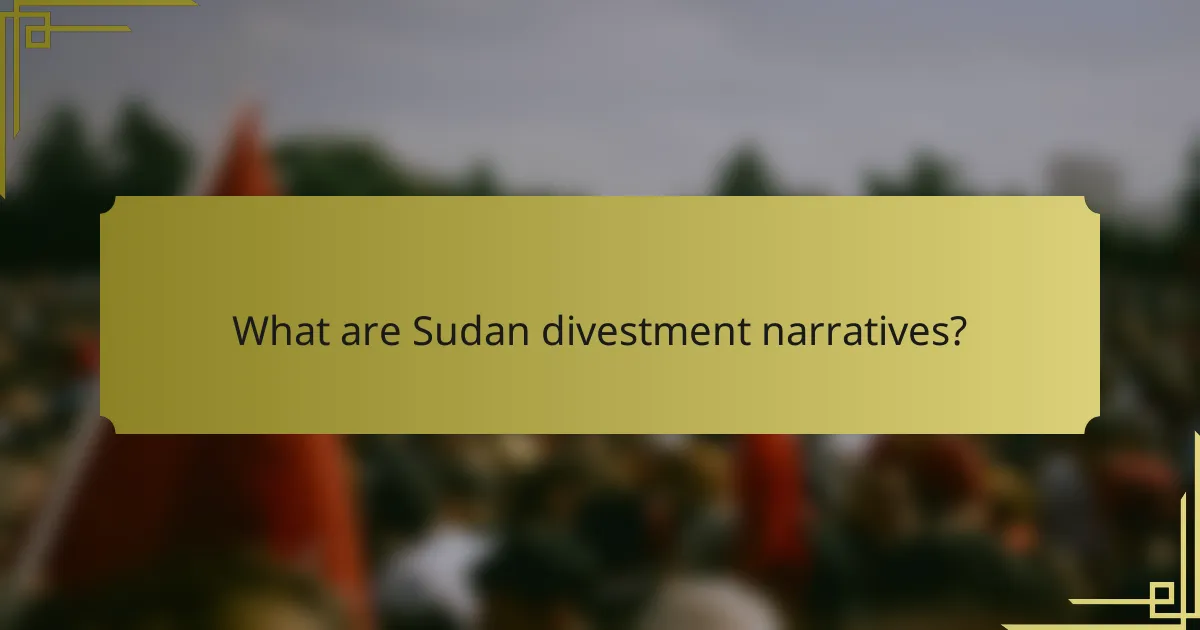
What are Sudan divestment narratives?
Sudan divestment narratives are stories and arguments that advocate for withdrawing investments from entities associated with the Sudanese government. These narratives often highlight human rights abuses and the ongoing conflict in the region. They aim to raise awareness about the ethical implications of financial support to the Sudanese regime. Activists and organizations use these narratives to mobilize public opinion and influence policy decisions. For instance, the Save Darfur Coalition has effectively utilized these narratives to garner support for divestment initiatives. Evidence shows that divestment can lead to economic pressure on governments. This pressure can, in turn, promote change and accountability.
How do storytelling techniques shape Sudan divestment narratives?
Storytelling techniques shape Sudan divestment narratives by influencing public perception and engagement. These techniques include personal anecdotes, emotional appeals, and structured narratives. Personal anecdotes create relatable connections, making the issue more tangible for the audience. Emotional appeals evoke feelings of empathy and urgency, driving action. Structured narratives provide clarity and context, helping audiences understand complex issues. For instance, campaigns highlighting individual stories of affected Sudanese families can mobilize support. Research indicates that narratives with emotional resonance are more memorable and impactful. This combination of techniques enhances awareness and drives divestment actions against entities linked to human rights abuses in Sudan.
What are the key elements of effective storytelling in this context?
The key elements of effective storytelling in the context of Sudan divestment narratives include clarity, emotional resonance, and authenticity. Clarity ensures that the message is easily understood by the audience. Emotional resonance engages the audience’s feelings, making the narrative relatable and impactful. Authenticity builds trust, as audiences are more likely to connect with genuine stories. Additionally, a compelling structure enhances the narrative flow, guiding the audience through the story effectively. Using real-life examples and testimonials adds credibility and reinforces the message. These elements combined create a powerful storytelling framework that influences public perception regarding Sudan divestment.
How do personal stories influence public perception of Sudan divestment?
Personal stories significantly influence public perception of Sudan divestment by humanizing complex issues. These narratives provide emotional context and relatability, making the topic more accessible. When individuals share their experiences, they evoke empathy and concern among audiences. This emotional engagement can drive public action and support for divestment efforts. Research shows that storytelling can effectively mobilize communities and influence policy decisions. For instance, personal accounts from Sudanese individuals affected by conflict highlight the urgency of divestment. These stories often resonate more than statistics or abstract arguments. Consequently, they can shape opinions and inspire collective action for change.
Why is storytelling important for Sudan divestment narratives?
Storytelling is important for Sudan divestment narratives because it humanizes complex issues. Effective storytelling engages audiences emotionally, making abstract concepts relatable. It helps illustrate the impact of divestment on individuals and communities in Sudan. By sharing personal stories, advocates can convey urgency and moral responsibility. This approach fosters empathy and drives public action. Research indicates that narratives can significantly influence public opinion and mobilize support for social causes. In the context of Sudan, compelling stories about the consequences of divestment can lead to increased awareness and advocacy efforts.
What role does emotional appeal play in shaping narratives?
Emotional appeal significantly influences the shaping of narratives. It engages audiences on a personal level, making stories more relatable. Emotional connections can evoke empathy and motivate action. For instance, narratives that highlight human suffering often drive public support for divestment initiatives. Research shows that emotional storytelling can lead to increased awareness and advocacy. A study by Green and Brock (2000) found that emotionally charged narratives enhance persuasion. This demonstrates that emotional appeal is a critical component in crafting effective narratives that impact public perception.
How can storytelling bridge gaps in understanding complex issues?
Storytelling can bridge gaps in understanding complex issues by simplifying intricate concepts. It transforms abstract ideas into relatable narratives. This method engages audiences emotionally and intellectually. For instance, stories can illustrate the human impact of policies, making them more tangible. Research shows that narratives increase retention of information by 65%. This is crucial in areas like Sudan divestment, where economic policies may seem distant. By personalizing these issues, storytelling fosters empathy and drives action. Ultimately, it turns complex data into accessible experiences that resonate with diverse audiences.
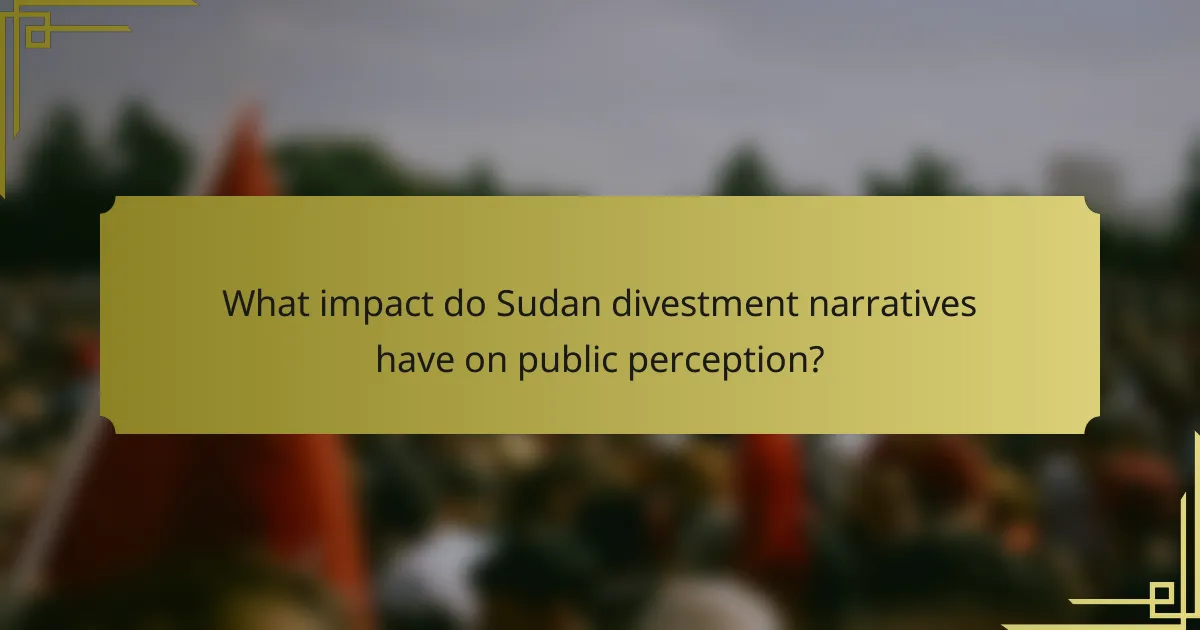
What impact do Sudan divestment narratives have on public perception?
Sudan divestment narratives significantly influence public perception by raising awareness of ethical concerns. These narratives highlight human rights abuses and environmental issues linked to investments in Sudan. As a result, they encourage consumers and investors to reconsider their financial choices. Public sentiment often shifts towards supporting divestment as a form of activism. This change in perception can lead to increased pressure on corporations to withdraw from Sudan. Studies show that such narratives can mobilize grassroots movements and influence policy decisions. The heightened visibility of these issues fosters a sense of social responsibility among the public. Overall, Sudan divestment narratives play a crucial role in shaping attitudes towards investment ethics.
How do these narratives influence public opinion and behavior?
Narratives influence public opinion and behavior by shaping perceptions and attitudes. They create emotional connections that can mobilize individuals toward action. In the context of Sudan divestment, these narratives highlight human rights abuses and the urgency for change. Research shows that storytelling can increase empathy and awareness, leading to greater public engagement. For instance, campaigns that focus on personal stories of affected individuals often result in higher levels of support for divestment efforts. This emotional resonance drives people to advocate for policy changes and financial actions against entities linked to human rights violations.
What are the measurable effects of narratives on activism and policy?
Narratives significantly influence activism and policy by shaping public perception and mobilizing support. They frame issues in relatable terms, making complex topics accessible. For instance, storytelling in the Sudan divestment movement highlighted human rights abuses, prompting grassroots activism. Research indicates that narratives can increase engagement levels by 30% compared to statistics alone. Furthermore, narratives can sway policymakers by illustrating the human impact of decisions. A study by the Stanford Social Innovation Review found that narratives led to a 40% increase in policy support among constituents. This demonstrates that effective storytelling can translate into measurable changes in public opinion and legislative action.
How do narratives affect the perception of stakeholders involved?
Narratives significantly shape the perception of stakeholders involved. They influence how stakeholders interpret events and actions. For instance, narratives can frame a situation in a positive or negative light. This framing affects stakeholders’ emotions and reactions. Research shows that storytelling can enhance empathy and understanding among audiences. A study by the University of Southern California found that narratives can increase support for social causes. The way a narrative is constructed determines its persuasive power. Effective narratives can mobilize stakeholders towards action or change. Thus, narratives play a crucial role in shaping stakeholder perceptions and responses.
What challenges arise in crafting Sudan divestment narratives?
Crafting Sudan divestment narratives faces several challenges. One major challenge is the complexity of the political situation in Sudan. The ongoing conflict and humanitarian crises complicate clear messaging. Additionally, there is a lack of comprehensive data on the impact of divestment. This makes it difficult to provide concrete evidence supporting the narratives. Another challenge is the potential backlash from stakeholders with vested interests. These stakeholders may resist narratives that threaten their financial interests. Furthermore, differing perspectives on the effectiveness of divestment can create confusion. This leads to mixed messages that dilute the intended impact of the narratives. Lastly, public awareness of Sudan’s issues is often low. This lack of awareness can hinder engagement and support for divestment efforts.
What are common misconceptions that narratives must address?
Common misconceptions that narratives must address include oversimplification of complex issues. Many people believe that divestment alone will solve the problems in Sudan. This ignores the multifaceted nature of the conflict and its root causes. Additionally, some narratives suggest that divestment will immediately lead to positive change. In reality, the impact of divestment can take time to manifest. Another misconception is that all companies involved in Sudan are equally complicit. This fails to recognize the varying degrees of involvement and responsibility among different entities. Lastly, some narratives imply that public awareness alone can drive change. However, meaningful action often requires coordinated efforts beyond just storytelling.
How can misinformation be countered through effective storytelling?
Effective storytelling can counter misinformation by presenting clear, relatable narratives that resonate with audiences. These narratives can simplify complex issues, making them easier to understand. By using emotional engagement, storytelling can foster connection and trust. Research shows that stories are more memorable than facts alone, enhancing retention of accurate information. For instance, a study from the Stanford Graduate School of Education found that narratives significantly improve comprehension and retention of facts. Furthermore, storytelling can highlight personal experiences, illustrating the real-world impact of misinformation. This approach encourages critical thinking and promotes informed discussions.
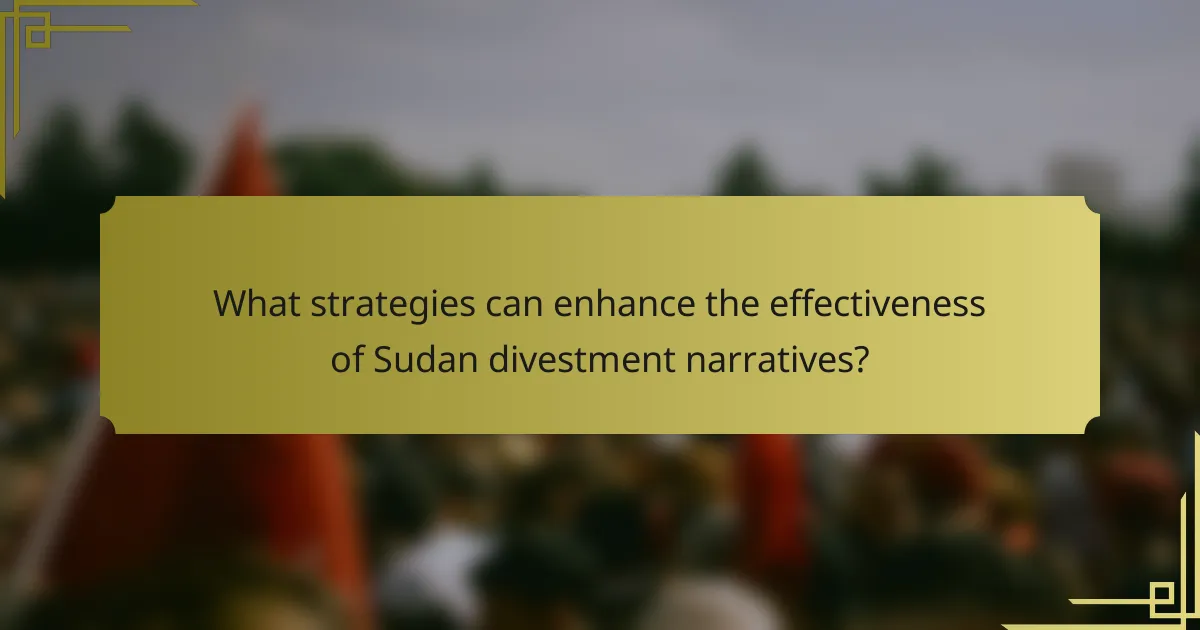
What strategies can enhance the effectiveness of Sudan divestment narratives?
Utilizing targeted messaging can enhance the effectiveness of Sudan divestment narratives. Tailoring narratives to resonate with specific audiences increases engagement. Incorporating personal stories from affected individuals humanizes the issue. Visual content, such as infographics and videos, can effectively convey complex information. Collaborating with credible organizations amplifies the message’s reach and authority. Leveraging social media platforms allows for broader dissemination and interaction. Engaging influencers can help mobilize communities and raise awareness. Lastly, providing clear calls to action encourages audience participation and advocacy.
How can organizations leverage social media for storytelling?
Organizations can leverage social media for storytelling by creating engaging narratives that resonate with their audience. They can share personal stories, testimonials, and experiences related to their mission or cause. This approach humanizes the organization and fosters emotional connections. Visual content, such as videos and images, enhances storytelling effectiveness. Data shows that posts with visuals receive 94% more views than text-only posts. Regularly engaging with followers through comments and shares builds community and encourages dialogue. Additionally, using hashtags can increase the reach and visibility of stories. A study by the Pew Research Center found that 69% of adults use social media, highlighting its potential as a storytelling platform.
What platforms are most effective for sharing narratives?
Social media platforms are most effective for sharing narratives. Platforms like Facebook, Twitter, and Instagram allow for wide-reaching engagement. They enable users to share stories quickly and visually. These platforms support multimedia content, enhancing narrative impact. Research shows that narratives shared on social media can increase public awareness and influence opinions. For example, a study by the Pew Research Center found that 69% of adults in the U.S. use social media, making it a powerful tool for storytelling. Additionally, platforms like YouTube facilitate longer narrative forms through video content, reaching diverse audiences.
How can visual storytelling complement written narratives?
Visual storytelling can enhance written narratives by providing immediate emotional engagement. Images and videos can evoke feelings more quickly than text alone. This emotional connection can lead to a stronger impact on the audience’s perception. For example, visuals of Sudan’s landscapes or affected communities can illustrate the narrative’s stakes. Research shows that people retain information better when it is presented visually. A study by the University of Minnesota found that visual aids can increase retention rates by up to 65%. Thus, combining visual storytelling with written narratives can make complex issues like Sudan divestment more accessible and compelling.
What best practices should be followed in creating Sudan divestment narratives?
Best practices in creating Sudan divestment narratives include using clear, factual language. Narratives should focus on the human impact of divestment. Highlighting specific cases of human rights abuses in Sudan is crucial. Engaging storytelling can enhance emotional connection and awareness. Utilizing credible sources to back claims strengthens the narrative’s validity. Incorporating statistics on economic impact can provide context. Collaboration with local voices can add authenticity. Finally, maintaining transparency about motives and goals fosters trust with the audience.
How can authenticity be maintained in storytelling?
Authenticity in storytelling can be maintained by ensuring accurate representation of experiences and facts. This involves thorough research to understand the cultural and historical context of the narrative. Engaging directly with individuals from the community being represented fosters genuine perspectives. Transparency about the storyteller’s own background and biases enhances credibility. Incorporating diverse voices adds depth and authenticity to the narrative. Lastly, consistent feedback from the community can help refine the story to reflect true experiences. Studies show that narratives grounded in real experiences resonate more with audiences, leading to greater impact and understanding.
What role does audience engagement play in narrative effectiveness?
Audience engagement is crucial for narrative effectiveness. Engaged audiences are more likely to connect emotionally with the story. This connection enhances retention of the narrative’s key messages. Research shows that narratives with high engagement lead to increased empathy and understanding. For instance, studies indicate that emotionally charged stories can influence public opinion and behavior. In the context of Sudan divestment narratives, effective engagement can mobilize support for action. Engaged audiences are more likely to share narratives, amplifying their reach and impact. Thus, audience engagement significantly enhances the overall effectiveness of narratives.
What are the key takeaways for crafting impactful Sudan divestment narratives?
Key takeaways for crafting impactful Sudan divestment narratives include clarity, emotional resonance, and factual accuracy. Clear messaging ensures that the audience understands the rationale behind divestment. Emotional storytelling can engage audiences, making the issues more relatable. Factual accuracy builds credibility and trust in the narrative. Utilizing real-life examples of affected communities can enhance the narrative’s impact. Statistics on economic and social consequences of investments can provide compelling evidence. Engaging visuals can also reinforce the message and attract attention. Lastly, aligning the narrative with broader ethical considerations can motivate action and support.
Sudan divestment narratives are compelling stories and arguments advocating for the withdrawal of investments from entities linked to the Sudanese government, primarily due to human rights abuses. The article explores how storytelling techniques, such as personal anecdotes and emotional appeals, shape these narratives and influence public perception and behavior regarding divestment initiatives. Key elements of effective storytelling, including clarity, emotional resonance, and authenticity, are discussed, along with the challenges and misconceptions faced in crafting these narratives. Additionally, the article highlights the role of social media and visual storytelling in enhancing narrative effectiveness, ultimately emphasizing the importance of audience engagement in driving activism and policy change.
